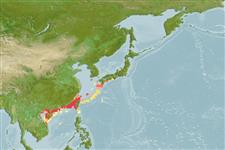Teleostei (teleosts) >
Eupercaria/misc (Various families in series Eupercaria) >
Sparidae (Porgies)
Etymology: Acanthopagrus: Greek, akantha = thorn + Greek, pagros, a kind of fish (Ref. 45335).
Environment: milieu / climate zone / depth range / distribution range
Ecology
Marine; freshwater; brackish; demersal. Subtropical; 34°N - 15°N, 105°E - 137°E
Northwest Pacific: limited to the east Asia Shelf, recorded only from the coasts of Honshu (including Seto Inland Sea), Shikoku and Kyushu Is., Japan (not Ryukyu and Ogasawara Is. or Sea of Japan), southern Korea, Taiwan, China (from around Shanghai to southern China) and northern Vietnam (south to Hué). Previous reports from other areas of the Indo-Pacific are misidentifications of species within the A. latus species complex.
Length at first maturity / Size / Weight / Age
Maturity: Lm 24.4 range ? - ? cm
Max length : 40.0 cm FL male/unsexed; (Ref. 108874); max. published weight: 1.5 kg (Ref. 40637)
Dorsal spines (total): 11; Dorsal soft rays (total): 10 - 11; Anal spines: 8 - 9; Vertebrae: 24. This species is distinguished from its congeners by the following set of characteristics: generally deep body in young specimens, becoming slender in larger adults, 2.14-2.70 (mean 2.42) times in SL: D usually XI,11 (very rarely XI,10); scale rows between fifth dorsal-fin spine and lateral line 3.5-4.5 (3.5 often observed in northwestern Kyushu Island and Seto Inland Sea, Japan, southern Korea and Vietnam, and in pre c. 1980 specimens in China, Taiwan and Japan; pers. obs.); scale rows above lateral line 4.5-5.5, scale rows below 10.5-12.5; second anal-fin spine longer than third anal-fin spine [14.6-24.8% (mean 20.6%) of SL], 1.19-1.58 (mean 1.40) in 2AS and 3AS; pored
lateral-line scales 44-47 (mean 45.2); the first soft dorsal-fin ray slightly longer than last dorsal-fin
spine; color of pelvic, anal and caudal fins mostly whitish yellow to strong vivid yellow, except contrasting lower yellow margin on caudal fin; black streaks near anal-fin base on inter-radial membranes between yellow anal-fin rays, even in preserved specimens; no black blotches on inter-radial membranes between dorsal-fin rays; a weak diffuse dark blotch at origin of lateral line (usually covering region of first pored lateral-line scale) continuing as relatively dense blackish shading on upper part of posterior opercle (Ref. 93743).
This species inhabits warm shallow and coastal waters, often entering river mouths and estuaries (Ref. 93743). Used in Chinese medicine (Ref. 12166). It is parasitised by the monogenean Anoplodiscus australis on the fins and body surface (Ref. 124057).
Iwatsuki, Y., 2013. Review of the Acanthopagrus latus complex (Perciformes: Sparidae) with descriptions of three new species from the Indo-West Pacific Ocean. J. Fish Biol. 83(1):64-95. (Ref. 93743)
IUCN Red List Status (Ref. 130435: Version 2024-1)
Threat to humans
Harmless
Human uses
Fisheries: commercial; aquaculture: commercial; gamefish: yes
Tools
Can't connect to MySQL database fbquizv2. Errorcode: Too many connections
